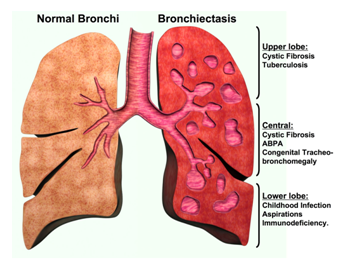Bronchiectasis Causes, Symptoms, Diagnosis and Treatment

What is Bronchiectasis?
Bronchiectasis is a condition where the bronchial tubes of your lungs are permanently damaged and enlarged. These damaged air passages let bacteria and mucus to build up in your lungs. This results in infections and blockages in the airways
Causes of Bronchiectasis
Damage to the walls of the airways usually is the cause of Bronchiectasis. A lung infection may cause this damage. Examples of lung infections that can lead to Bronchiectasis include:
- Severe pneumonia
- Whooping cough or measles (uncommon in the United States due to vaccination)
- Tuberculosis
- Fungal infections
Conditions that damage the airways and raise the risk of lung infections also can lead to Bronchiectasis. Examples of such conditions include:
- Cystic fibrosis
- Immunodeficiency disorders
- Allergic bronchopulmonary aspergillosis
- Disorders that affect cilia (SIL-e-ah) function.
- Chronic (ongoing) pulmonary
- Connective tissue diseases, such as rheumatoid arthritis, Sjögren’s syndrome, and Crohn’s disease.
Other conditions, such as
- An airway blockage.
- A growth or a noncancerous tumor.
- An inhaled object, such as a piece of a toy etc
Symptoms of Bronchiectasis
Symptoms of Bronchiectasis can take months or even years to develop. Here are some of the symptoms:
- Chronic coughing
- Coughing up blood
- Abnormal sounds or wheezing in the chest on breathing
- Shortness of breath
- Chest pain
- Coughing up large amounts of mucus daily
- Bad breath odor
- Skin with a blue appearance
- Weight loss
- Fatigue
- Thickening of the skin under your nails and toes
Diagnosis of Bronchiectasis
Diagnosis of Bronchiectasis begins with history and physical inspection. Bronchiectasis can be confirmed through following tests:
- Sputum test to check your mucous for viruses or bacteria
- Chest X-ray or CT scan to provide images of your lungs
- Pulmonary function tests to find out how well air is flowing into your lungs
- Purified protein derivative (PPD) skin test to check for tuberculosis
Treatment of Bronchiectasis
Early diagnosis and treatment of the underlying cause of Bronchiectasis may help prevent further lung damage. In addition, any disease associated with the Bronchiectasis, such as cystic fibrosis or immunodeficiency, also should be treated.
Medicines
- Antibiotics
- Macrolides
- Expectorants
- Mucus-Thinning Medicines
Chest Physical Therapy
Some people find CPT hard or uncomfortable to do. Several devices can help with CPT, such as:
- An electric chest clapper, known as a mechanical percussor.
- An inflatable therapy vest that uses high-frequency air waves to force mucus toward your upper airways so you can cough it up.
- A small handheld device that you breathe out through. It causes vibrations that dislodge the mucus.
- A mask that creates vibrations to help break loose mucus from your airway walls.
Other Treatments
- Bronchodilators
- Inhaled Corticosteroids
- Oxygen Therapy
- Surgery
Bronchiectasis is a chronic condition with repeated exacerbations that can develop slowly over a few weeks or rapidly over a few days. It is important to incorporate self-care strategies into daily life, including taking oral and inhaled medications, performing mucus clearance techniques, and getting plenty of rest.
By : Natural Health News




